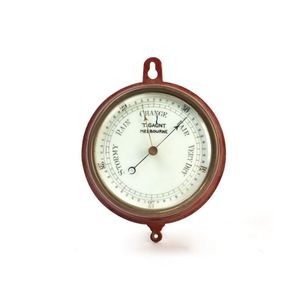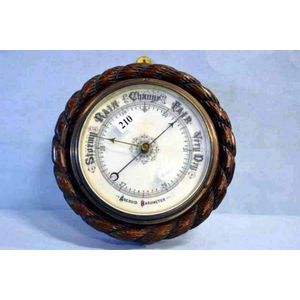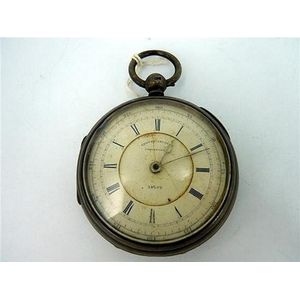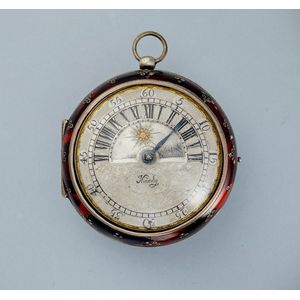David Gordon Dublin Verge Watch with Sun and Moon Dial
A David Gordon, Dublin tortoiseshell and silver pair case verge watch with 'Sun and moon' dial, gilt fullplate movement with fusee, engraved and pierced balance cock. verge escapement. Egyptian columns. The fullplate signed Davd Gordon Dublin, with serial number 842. The silver face with a 'Sun and moon' dial for the hours and a outer Arabic numeral ring for the minutes, indicated with the blued poker hand. The face signed 'Manly' to the centre, encompassed with engraved foliate scrollwork. The silver inner case signed 'Lc', with winding hole. The outer tortoiseshell case with silver pique work to bezel and rear, culminating in a pique hunting scene surrounded by foliate scrollwork. Diameter: 50 mm. Provenance: The collection of Dr Trevor Hyde, Sydney
You must be a subscriber, and be logged in to view price and dealer details.
Subscribe Now to view actual auction price for this item
When you subscribe, you have the option of setting the currency in which to display prices to $Au, $US, $NZ or Stg.
This item has been sold, and the description, image and price are for reference purposes only.
- Bezel - On a clock or watch, the bezel is the metal frame into which the watch or clock glass is fitted. In clocks, the bezel may include a hinge and a flange, in effect a door to the face of the clock. In jewellery the bezel is a band of metal with a projecting lip that holds the gemstone in its setting.
- Verge Escapement - A verge escapement is an early mechanical escapement used in clocks and other timekeeping devices. It is an early form of the escapement mechanism, which is used to regulate the movement of the hands of a clock or watch. The verge escapement consists of a vertical shaft called the verge, which is mounted on the clock's main plate. Attached to the verge are two pallets, which engage with the teeth of the escape wheel. As the escape wheel turns, the pallets alternately lock and release it, allowing the movement of the clock to be regulated. The verge escapement was widely used in early mechanical clocks, but it was eventually replaced by the more accurate and reliable anchor escapement.
- Tortoiseshell - Tortoiseshell is a translucent material that comes from the horny carapace of a certain types of turtles, including the hawksbill turtle. It is often therefore mounted on a colour underground - often red - or inlaid with gold or silver thread, as seen in Boulle furniture.
The texture and colour nuances of the material are extremely important. Heated tortoiseshell can easily be formed into various shapes. Like other natural materials, tortoiseshell becomes more beautiful with use. In a time before plastic, tortoiseshell was widely used for small objects such as combs and powder compacts.
In 1973, the trade of tortoiseshell worldwide was banned under CITES (The Convention on International Trade in Endangered Species). Prior to importing or exporting items containing tortoiseshell a CITES permit must be obtained. Tortoiseshell items cannot be traded on Ebay.
"Faux tortoiseshell", another case of man initiating nature, is made from old-style plastics such as celluloid and cellulos and is coloured with red, yellow and brown spots to imitate the genuine article. It is commonly used in glasses frames, musical instruments and costume jewellery. - Pique Work - A decorative technique used on jewellery and small decorative objects in which designs are created by inlaying small gold or silver studs and stips into tortoiseshell. The art reached its highest point in 17th- and 18th-century France, particularly for the decoration of small tortoiseshell articles such as combs, patch boxes, and snuffboxes.
- Fusee - The fusee movement was used in clocks and pocket watches from the mid 17th century. The fusee is a cone shaped drum within the works that is linked to the barrel of the spring, usually by a length of chain.
As the mainspring loses its tension over time, the cone shaped barrel compensates for this by increasing the tension, by pulling the mainspring tighter, thus ensuring the time remains constant.
Use of the fusee in clocks was superseded by the "going barrel" in the mid 19th century and for pocket watches at the beginning of the 19th century.
The fusee continued to be used in marine chronometers until the 1970s. - Foliate - Decorated with leaves or leaf-like forms.
- Moon Dial - If we imagine life in the 17th century, the only source of ascertaining the time of day or night would have been the local church or municipal clock striking every quarter hour, and able to be heard by all in the village. In England, when longcase clocks became popular and more affordable in the late 17th century, the function of timekeeping and source of time was moved to within the home.
An additional feature on some longcase clocks was to display the phases of the moon, that is the new moon, the full moon and the waning moon over the lunar 29 ½ day cycle. This information was important for farmers for working out cropping schedules; for travellers to know the amount of moonlight on a night they planned to travel; and for those who lived near the sea required knowledge of the tides.
Where included, the moon dial is usually in the form of a disc incorporated into the main dial plate, usually in the arched top section. The lunar cycle starts with the new moon displaying, which is a dark night sky and no man-in-the-moon face being displayed, and then progresses to the full moon face showing on the 15th day of the lunar cycle, and back to no face displaying as the moon wanes. Most lunar dials are partially concealed on each side of their opening in the main dial plate by semi-circular "humps" that allow the painted face to emerge slowly just as the real moon goes out of and back into the earth's shadow.
Nowadays, details of the lunar cycle is published in diaries, almanacs, and newspapers and although some modern longcase clocks are still manufactured with working moon dials, they are more for decoration than for use. - Movement - The technical name for the workings of a clock or watch, and does not include the dial or case.
This item has been included into following indexes:
- clocks, material or decoration - tortoiseshell cased 99
-
pocket watches, case type
- hunter, silver cased 129
- open face, silver case 514
- pair cased 143
- silver case 816
Visually similar items

A silver chronograph pocket watch by centre seconds, Chester, 1900. Case number: 144152. Weight: 180.6g
Sold by
in
for
You can display prices in $Au, $US, $NZ or Stg.

A wall barometer made for T. Gaunt of Melbourne, circa 1900, cast iron housing with brass bezel, 16 cm diameter
Sold by
in
for
You can display prices in $Au, $US, $NZ or Stg.

Quality Oak 'Rope' framed barometer
Sold by
in
for
You can display prices in $Au, $US, $NZ or Stg.

A silver centre seconds chronograph pocket watch. Case by James Neale, Chester, 1882. Weight: 151.3g
Sold by
in
for
You can display prices in $Au, $US, $NZ or Stg.
